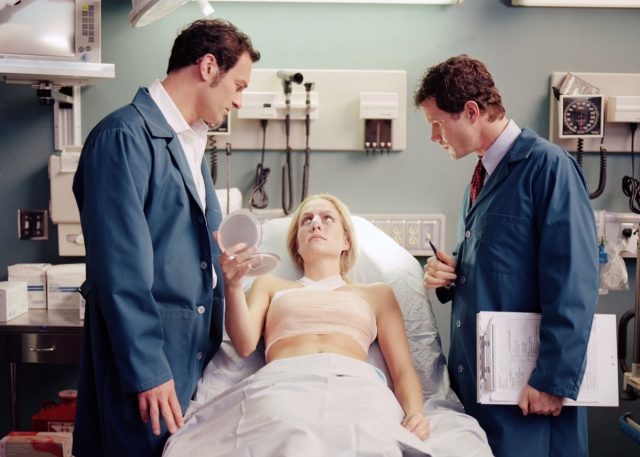
Fat transfer (or liposculpture) is one of the most popular fat transfer procedures among Hollywood stars. Allows you to adjust the proportions of the body and face. For example, to enlarge breasts, hips or cheekbones. That’s why Kim Kardashian, Jennifer Lopez and Nicki Minaj love it. Dmitry Blinov, a plastic surgeon with 15 years of experience, explained what lipofilling is, in which areas it is performed and what contraindications there are.

Dmitry Blinov, plastic surgeon
What is it?
Lipofilling is an operation that allows you to solve a number of problems associated with age-related changes in soft tissues using the patient’s own fat tissue. It is a natural alternative to other materials such as fillers or silicone fillings.
Why?
The discovery of adipose tissue stem cells in 1908 led researchers to develop devices that could isolate these cells from fat during liposuction. It is assumed that the transplanted stem cell-rich fat tissue allows the grafting of cells with almost a hundred percent probability and contributes to the rejuvenation of surrounding tissues. Therefore, the lipofilling technique can be performed for various purposes – to obtain additional volume and rejuvenate the tissue in the area of fat injection.
What can be done?

Fat tissue injections are a safe and effective method for face and body correction. With the help of fat tissue transplantation, you can enlarge the mammary glands, hips, and add volume to the lips and cheekbones.
How is lipofilling done?
— In the donor areas (mostly the abdomen and inner thighs), the surgeon makes several small holes.
“The surgeon then uses a special tool to remove the fat cells.
— After this, the donor material is subjected to purification.
— The prepared fat tissue is injected into the required areas and distributed evenly.
As a rule, the operation is performed under local anesthesia. The procedure usually takes from half an hour to four hours. Duration depends on the complexity and scope of the operation. After the operation, the patient must stay in the clinic for a short time until his health returns to normal. Although the procedure is considered safe and less traumatic, it still has contraindications.
Indications and contraindications

Indication liposculpture may include:
– pronounced nasolabial folds;
– lack of fatty tissue in the middle or lower third of the face;
– pronounced asymmetry or insufficient volume of the cheekbones, lips, chin;
— lack of fatty tissue after plastic surgery.
Contraindications It is almost the same as other interventions:
– diabetes;
— diseases of the cardiovascular system;
– serious chronic diseases;
– tendency to form keloid scars;
– poor blood clotting;
– kidney failure;
– hormonal imbalance;
– viral and infectious diseases in the acute stage;
– pregnancy, breastfeeding.
Are there any complications after the surgery?
Yes, just like any surgical intervention. Complications may occur if the doctor’s recommendations are not followed and during postoperative rehabilitation. Therefore, it is important to follow all instructions and recommendations to minimize the possibility of complications.
Pros and cons of the procedure

Between benefits We can distinguish lipofilling operations as follows.
– No allergic reaction. The patient’s own fat tissue is used to replenish the required volumes, so the likelihood of rejection will be extremely low.
– Natural effect. Again, since the patient’s own fat is used during the operation instead of fillers and implants, the result is more natural.
— Fat can be removed from problem areas, as the graft is taken from areas most susceptible to the accumulation of fat deposits.
— The operation is performed under local anesthesia, not general anesthesia.
Rapid rehabilitation (in the absence of complications). For example, after facial liposculpture, some patients leave the clinic on the same day. But body correction is more difficult.
Cons There is also an operation.
– Fragility. How long the effect of surgery lasts directly depends on individual characteristics, the patient’s genetics, and care during and after rehabilitation. Therefore, it is not possible to say for sure how long the result will last.
— Volume increase. Lipofilling method is not suitable for serious breast or hip enlargement. In cases where the patient wants to significantly renew his body volume, implant placement may be necessary.
Which is better: lipofilling or fillers?
Fat grafting is often referred to as an improved version of fillers. After all, the procedure provides a natural effect that lasts for several years (not months).
But both procedures have their own indications and contraindications, so only a competent specialist can determine which one is suitable for you.
Source: People Talk
I’m Roger Gritton, and I’ve been writing for the The Fashion Vibes for over 5 years now. My specialty is beauty news; I’m passionate about covering the latest trends, products, and innovations in the industry. In my time there, I’ve become known as an authority on all things beauty-related.
I love discovering new experts to interview, researching up-and-coming ingredients and techniques that are making their way onto our beauty shelves and highlighting people who are making a difference in the world of cosmetics. My work has appeared not only on The Fashion Vibes, but also several other publications including the New York Times Magazine, Allure Magazine and Refinery29.




